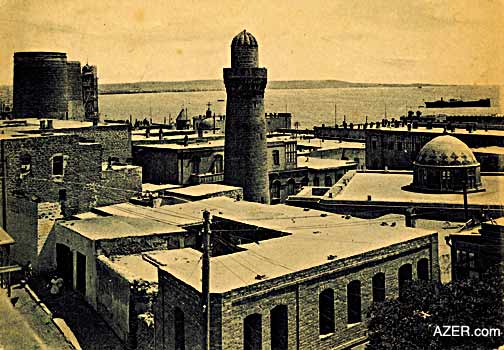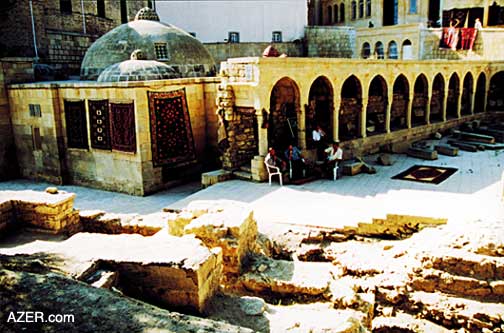|

Autumn 2004 (12.3)
Pages
46-47
14th Century Baku
When Caspian Waves Lapped Maiden's Tower
by Abdurrashid Bakuvi
Abdurrashid Bakuvi was a famous
Baku scholar of the 14th-15th centuries who provided a description
of Baku's Inner City (Ichari Shahar) in his famous text on geography
entitled, "A Short Description of the Monuments and Magical
Deeds of the Almighty Lord". He describes what was known
in those times about countries and settlements throughout the
world, including Baku. He wrote in Arabic. The only original
manuscript is housed at the Paris National Library; a copy exists
in the Institute of Manuscripts in Baku.
Baku is a city of stone construction
built along the coast of the Caspian, which is located in the
region of Darband [city on the Caspian Sea, now in Dagestan,
Russia] and Shirvan [northwest of Baku]. [Shirvan was an historical
province-the mountainous region between Caspian Sea and the Kur
River. The main medieval cities were Darband, Shamakhi and Baku,
which was also considered part of the Shirvan region. Baku was
the capital of the rulers of Shirvan-the Shirvanshahs at this
time.]

Above: Early 20th century showing view in
Baku's Old City (Ichari Shahar) towards the Caspian Sea. Left:
Maiden's Tower, center: Friday Mosque. Postcard: courtesy of
Khalida Nasirova
The city walls are enveloped by water from the sea. The water
reaches most of the towers and approaches the mosque [probably
a reference to Mohammad Mosque which was built in the 11th century].
The ground is rocky and most of the houses are constructed upon
rock. The air is good, the water is sweet and comes from wells
in rocky places. The water in the wells finds its source from
underground springs.
The harvest of grains is poor here. Wheat is brought from Shirvan
and Mughan. [The author is referring to wheat that was brought
to Baku inland from Shirvan, located to the northwest. Mughan
is located on the steppes between the Shirvan and the Talish
region. During medieval times, many villages produced wheat and
other grains. These days, towns such as Salyan, Neftchala, Ali-Bayramly
and Haji Gabul are located there.]
There are many figs, pomegranates and grapes growing here. The
gardens [meaning the summer homes which are often referred to
as "dachas" these days] are quite distant from the
city, and most people spend their summers there, stay for awhile
and then return to the city. This happens every year.
The city has two extremely strong fortresses, which are built
of stone. One of them [the Maiden's Tower] is larger and stands
along the seacoast and its walls are washed by waves. It is the
same fortress that the Tatars were not able to capture. [The
author refers to the Mongolian Invasion of the 13th century.]
The second fortress is situated at a higher location than the
first. The upper part of this fortress was destroyed by Manjanigs.
[It is likely that the author is referring to the Tower which
still stands today and which forms part of the wall of the Ismayiliyya
Building, or Presidium of the Academy of Science. Manjanigs were
a tribe of Mongols].
One of peculiarities of this city is that winds blow incessantly
all day long. Sometimes, when strong wind blows, one can't resist
or stand up against them. During the winter, the winds are so
strong that they sometimes blow horses and sheep into the sea.
Evidence of Oil
Below: In Baku's Old City (Ichari
Shahar). One of the bathhouses and market centers
which are located directly behind Maiden's Tower. Currently,
more archaeological excavations are being carried out at this
location.

There are fields of pitch (bitumen) and springs of oil here.
Every day more than 200 barrels of oil are loaded up and carried
out by camels. Nearby is another spring of white oil resembling
jasmine oil which continues day and night long without interruption.
Its rent price is about 1,000 dirhams.
[Dirham is a silver coin, which during medieval times was spread
throughout the Muslim world including Azerbaijan. The medieval
dirham was a specific weight of pure silver equivalent to 3.0
grams. This oil field was leased for 1,000 dirhams-3 kg of pure
silver approximately US $500. Possibly the owner was Shirvanshah-the
ruler of Shirvan. However, the author doesn't write if this sum
was paid monthly or annually.
Nearby these springs of oil, the ground is a deep yellow color
and burns like a candle [earth that is heavily saturated with
oil]. The people gather clumps of this soil and bring it to the
city to be used at heating houses and bathhouses.
At a distance of one farsah (approximately 3 miles) from the
city, there is a place that is always ablaze with an eternal
fire. It is said that its source is sulfur. There is a village
in neighborhood with a population who are Christians [Tats continued
to follow Christianity since the times of Caucasian Albania (3rd
and 4th century AD). According to the scholar Bakuvi even in
the Middle Ages, the Tats made up a significant portion of the
population in villages nearby Baku, although people in Baku had
converted to Islam after the Arabic invasion].
They burn lime [slaked lime-CaCO3] and bring it by horse-drawn
wagons to the city. There are salt mines of excellent quality
here as well and the salt [edible salt containing iodine] is
exported to other countries as well. Nearby the city, there is
an island [Nargin] where people go to hunt seals. The skin is
removed from seals and their fat is melted and used for lamps.
People use sealskins for making leather bags which they fill
with oil to transport to foreign countries.
There are so many gazelles here that it is impossible to compare
them with any other place. [In the past, all the steppes and
semi-desert regions around Baku were filled with herds of jeyrans
(gazelles). Now, they have disappeared from the Absheron peninsula
completely, but can be found in the Shirvan Preserve.]
Sometimes it is possible to see a great fire emanating from the
sea, rising to a great height. Sometimes, it can be seen from
a distance of two or more days' journey. This fire erupts after
burning for a long time.
There are many villages around the city. Residents of some of
them are Christians. The people in the city are Shafei Muslims
[Shafei refers to the largest and most important "mazhab"-teachings-of
the Sunni branch of Islam]. May Allah be pleased!
This is the native land of my father Saleh ibn Nuri, who was
a religious leader and scholar of great acclaim. He died in 1404
when he was 77 years old.
Dr. Farid Alakbarov found Bakuvi's
14th century diary at the Institute of Manuscripts where he directs
the Department of Translation and Intormation. Alakbarov's own
scholarly research deals primarily with Medieval Medical Manuscripts.
Search at AZERI.org for his articles in English and Azeri.
From Azerbaijan International (12.3) Autumn 2004.
© Azerbaijan International 2004. All rights reserved.
Back to Index AI 12.3 (Autumn
2004)
AI Home
| Search | Magazine
Choice
| Topics
| AI Store | Contact us
Other Web sites
created by Azerbaijan International
AZgallery.org | AZERI.org | HAJIBEYOV.com
|


